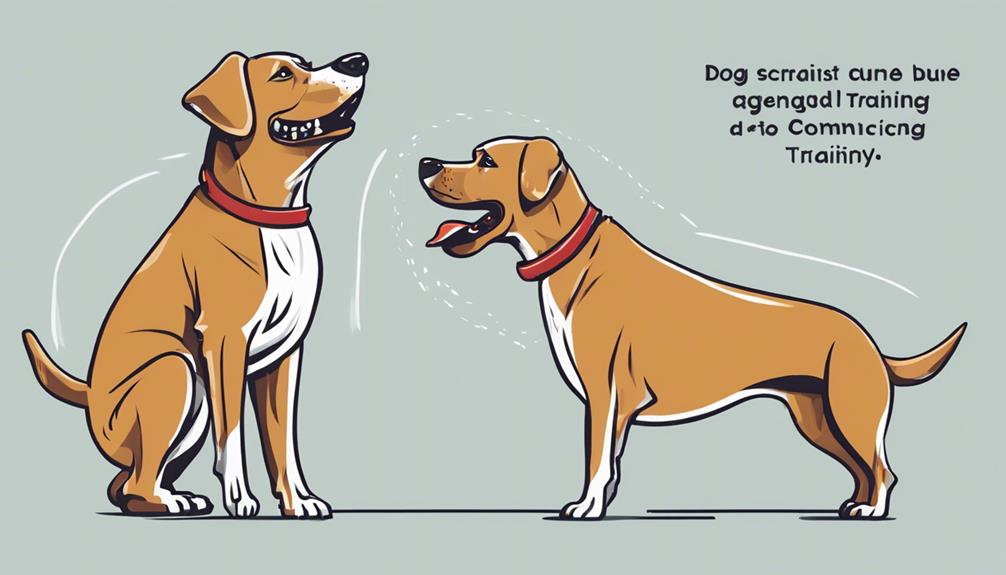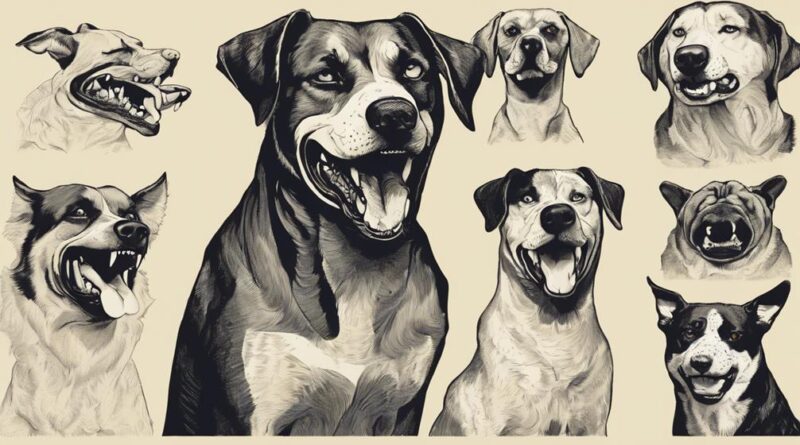Why Does Dog Communication Vary: Aggressive Vs Friendly?
When observing dogs, have you ever noticed how their communication styles can range from displaying aggression to exhibiting friendliness? Understanding the underlying reasons for these variations can provide valuable insights into canine behavior and interaction.
By exploring the factors that influence dogs' communication patterns, you can gain a deeper understanding of why they may express themselves in different ways.
Stay tuned to uncover the intricate dynamics behind dogs' aggressive and friendly communication tendencies.
Canine Body Language Signals
Understanding canine body language signals is crucial in discerning a dog's emotions and intentions accurately. Canine communication relies heavily on body language cues, which can indicate whether a dog is feeling friendly, anxious, fearful, or aggressive.
When a dog is relaxed and comfortable, you may notice a wagging tail, loose body posture, and soft eyes. These signals typically suggest a friendly and approachable demeanor. On the other hand, if a dog displays tense body language such as raised fur, a stiff posture, or a fixed stare, it may indicate feelings of aggression or fear.
Learning to interpret these subtle cues can help you navigate interactions with dogs more effectively and avoid misunderstandings. Paying attention to a dog's body language cues can also enhance your ability to communicate with them nonverbally, fostering a deeper connection and understanding between you and your canine companion.
Understanding Aggressive Dog Behavior
Paying close attention to signs of tension in a dog's body language can help you identify potential signals of aggression and better understand aggressive dog behavior. Recognizing warning signs such as a stiff body, intense staring, raised fur, growling, or showing teeth is crucial in managing aggressive behavior in dogs. When a dog displays these signs, it's essential to remain calm and avoid escalating the situation.
To manage aggressive behavior, start by creating a safe distance between the dog and whatever is causing the aggression. Avoid punishing or yelling at the dog, as this can increase their stress levels and escalate the aggression. Instead, try redirecting their attention to something positive, like their favorite toy or a treat. Seeking professional help from a dog behaviorist or trainer is also advisable when dealing with aggressive behavior, as they can provide tailored strategies to address the issue effectively.
Understanding aggressive dog behavior is key to ensuring the safety of both the dog and those around them. By recognizing warning signs and implementing appropriate management techniques, you can help your dog navigate their emotions and interactions more effectively.
Interpreting Friendly Dog Gestures
To accurately interpret friendly dog gestures, observe their body language and tail wagging patterns. When dogs are engaging in playful interactions, they exhibit specific non-threatening gestures that indicate their friendly demeanor. Look for signs such as a relaxed body posture, loose and wiggly movements, and a gently wagging tail.
Friendly dogs often approach with a curved body, as if they're doing a play bow, which is a clear invitation to interact in a positive manner. Their ears are usually relaxed or perked up slightly, and they may have a soft gaze with a slightly open mouth.
Tail wagging is a key indicator of friendliness, but it's essential to consider the context and speed of the wag. A broad, slow wag is typically a good sign, while a stiff, rapid wag could signal tension or uncertainty. By paying attention to these cues and understanding their body language, you can effectively recognize when a dog is offering friendly gestures during interactions.
Factors Influencing Dog Communication
When gauging dog communication, various factors play a significant role in influencing their interactions with humans and other animals. Breed influence is one crucial aspect to consider, as different breeds have been selectively bred for various traits that can impact their communication styles. Environmental factors, such as the dog's living conditions and exposure to stimuli, also shape how they communicate. Socialization impact is another key factor; dogs that have positive socialization experiences tend to communicate more effectively and confidently.
Owner dynamics play a vital role in how a dog communicates, as the relationship between a dog and its owner greatly influences the dog's behavior. A supportive and understanding owner can help a dog feel more secure and express themselves better. On the contrary, negative owner dynamics can lead to communication issues and potentially aggressive behavior. By considering these factors, you can better understand why dogs communicate in the ways that they do and work towards fostering positive interactions with your canine companion.
Recognizing Aggression Cues in Dogs
How can you accurately identify aggression cues in dogs during interactions? Recognizing aggression triggers is crucial for ensuring safe and positive interactions with dogs. One key aspect is reading warning signs that indicate a dog may be feeling threatened or uncomfortable. These signs can include a stiff body posture, growling, baring teeth, raised hackles, intense staring, and snapping. If you notice these behaviors, it's essential to give the dog space and avoid escalating the situation.
Aggression triggers can vary between individual dogs and situations. Some common triggers include feeling cornered, possessiveness over toys or food, being in pain, feeling threatened by strangers or other animals, or being startled. Understanding these triggers can help you anticipate and prevent aggressive behavior.
To promote a safe environment, always approach dogs calmly and respectfully. Allow them to initiate contact and observe their body language for any signs of discomfort. By being attentive to aggression cues and responding appropriately, you can help create a positive and harmonious interaction for both you and the dog.
Promoting Positive Interactions Among Dogs
Recognizing aggression cues in dogs is crucial for ensuring safe and positive interactions, but equally important is fostering an environment that promotes positive interactions among dogs.
To create a harmonious atmosphere for your furry companions, consider the following:
- Encourage Playful Interactions: Facilitate opportunities for dogs to engage in playful activities together, such as fetching a ball or playing with interactive toys. Play helps dogs release energy and build bonds with one another.
- Focus on Socialization Skills: Regularly expose your dogs to different environments, people, and other dogs. This exposure helps them develop socialization skills, making them more comfortable and confident in various situations.
- Provide Supervision: Always supervise interactions between dogs, especially when they're getting to know each other. This allows you to intervene if needed and ensures that interactions remain positive.
- Reward Positive Behavior: Reinforce good behavior with treats and praise. Positive reinforcement helps dogs associate good behavior with positive outcomes, encouraging them to continue behaving well during interactions.
Importance of Consistent Training Methods

To ensure effective communication and behavior consistency in dogs, employing consistent training methods is paramount. Behavior modification relies heavily on repetition and reinforcement of desired actions. By using the same cues and commands consistently, you help your dog understand what's expected of them. Dogs thrive on routine and clear expectations, making training consistency a key factor in their development.
Inconsistent training methods can confuse dogs, leading to misunderstandings and unpredictable behavior. If you switch between rewarding a behavior one day and punishing it the next, your dog may struggle to grasp the desired actions. Consistency creates a stable learning environment, helping your dog build confidence and trust in you as their leader.
Training consistency isn't only essential for behavior modification but also for strengthening the bond between you and your furry friend. When your dog knows what to expect from you, they feel secure and are more likely to exhibit positive behaviors. By maintaining a consistent approach to training, you set the foundation for healthy communication and a harmonious relationship with your dog.
Building Trust for Healthy Dog Communication
Establishing trust forms the foundation for fostering healthy communication with your dog. Building rapport and establishing boundaries are key elements in developing a strong bond with your furry companion. To ensure effective communication, consider the following:
- Consistency is Key: Dogs thrive on routines, so be consistent in your interactions and training methods. This predictability helps them feel secure and build trust in you as their leader.
- Positive Reinforcement: Reward good behavior with treats, praise, or playtime. This encourages desired actions and strengthens the connection between you and your dog.
- Clear Communication: Use clear cues and body language to convey your expectations. Dogs are observant and will respond better when they understand what you want from them.
- Respect Your Dog's Limits: Just like humans, dogs have boundaries. Pay attention to their body language and signals to know when they've had enough, and always respect their personal space.
Frequently Asked Questions
How Do Dogs Communicate Differently With Other Animals Compared to Humans?
Dogs communicate differently with other animals compared to humans by using a combination of canine body language, vocalizations, and scent signals. Through interspecies communication, dogs adjust their signals based on the recipient. They may rely more on body language and scent when interacting with other animals, whereas with humans, vocalizations like barking or growling may play a more prominent role.
Understanding these variations can help improve communication and relationships between dogs and different species.
Can a Dog's Breed Affect Its Communication Style and Tendencies?
When it comes to a dog's breed, their communication style and tendencies can be influenced by various factors. Breed characteristics and genetic predispositions play a role, but so does socialization and training techniques.
Different breeds may have unique ways of expressing themselves and interacting with others. It's important to consider these aspects when understanding how a dog communicates and to tailor your approach based on their specific breed traits.
Is There a Correlation Between a Dog's Past Experiences and Its Communication Behavior?
When it comes to your furry friend's communication behavior, past experiences play a significant role. Childhood trauma or lack of socialization can affect how your dog interacts with others.
Behavioral therapy and trust-building exercises can help address these issues. By understanding your pup's history and taking steps to build positive experiences, you can help shape their communication style and tendencies, fostering healthier interactions with both humans and other dogs.
Do Dogs Communicate Differently With Puppies Than They Do With Adult Dogs?
When dogs interact with puppies, they often adjust their communication to match the younger dog's level. Playful interactions and gentle vocalizations are common, along with relaxed body language to encourage positive social cues.
Dogs may exhibit more patience and tolerance towards puppies, guiding them through appropriate behavior with their own communication styles. This helps in fostering a healthy relationship between dogs of different age groups.
Are There Specific Ways to Train a Dog to Improve Its Communication Skills With Other Dogs?
To improve socialization and your dog's communication skills with other dogs, consider using specific training techniques. Start by exposing your dog to various social situations gradually.
Encourage positive interactions and reward good behavior. Consistent training and practice can help your dog feel more comfortable and confident when interacting with other dogs.
Conclusion
In conclusion, understanding why dog communication varies between aggressive and friendly behaviors is essential for promoting positive interactions among dogs. By recognizing body language signals and factors influencing their behavior, you can effectively interpret their gestures and prevent potential aggression.
Consistent training methods and building trust are key in fostering healthy dog communication, ensuring a harmonious relationship between dogs and their owners. Remember, communication is key in strengthening the bond with your furry companions.
